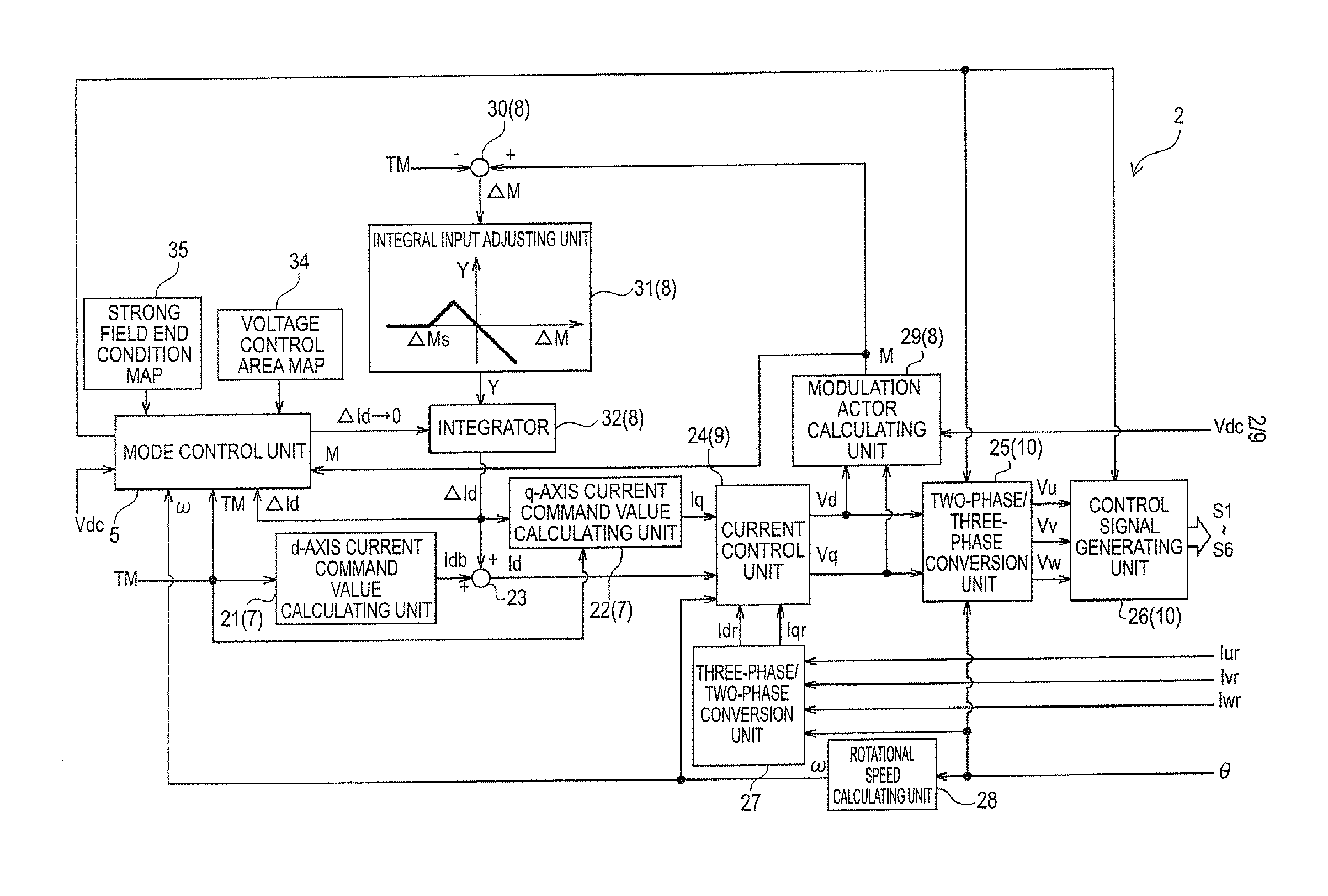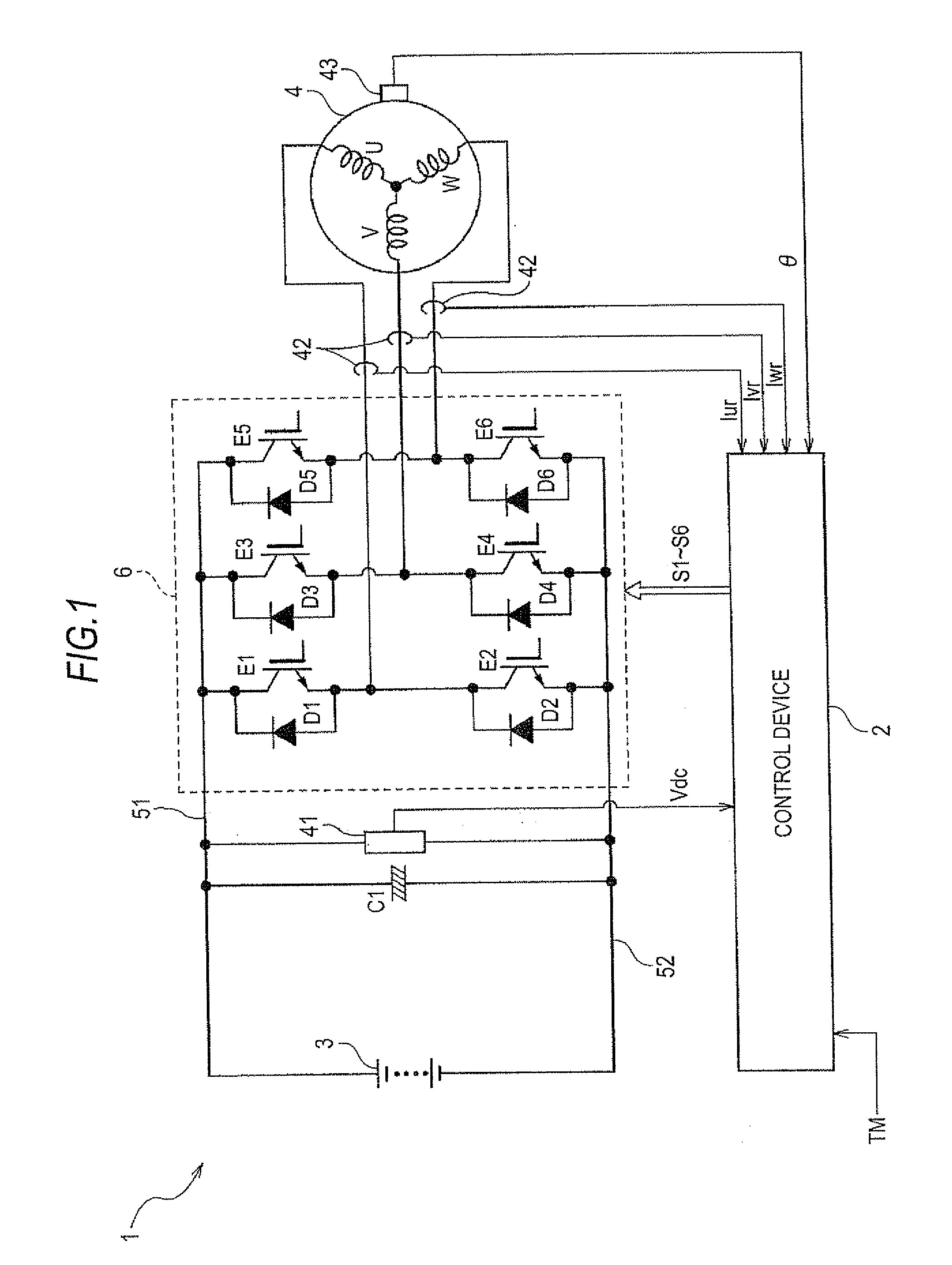[0011]According to this structure, the strong field control is performed on the basis of the voltage index indicating the magnitude of the voltage command value with respect to the
DC voltage. When the strong field control is performed, the voltage index increases to change the voltage waveform control to the square wave control. Therefore, it is possible to expand the operation region in which the square wave control of the AC motor is performed and reduce the switching loss of the DC / AC conversion unit. As a result, it is possible to improve efficiency. In addition, in this case, the field adjusting unit appropriately determines the field adjustment command value to change the intensity of the strong field. In this way, it is possible to appropriately output a torque corresponding to the target torque to the AC motor, regardless of the rotational speed of the AC motor. According to this structure, the strong field control ends on the condition that the field adjustment command value is equal to or greater than the adjustment command threshold value determined on the basis of the target torque and the voltage / speed ratio in the direction in which the field flux is strengthened. Therefore, it is possible to appropriately end the strong field control before efficiency is reduced due to an increase in the field adjustment command value. That is, it is possible to appropriately end the strong field control according to the relationship between an increase in the loss of the motor due to an increase in the field adjustment command value and a reduction in switching loss due to the execution of the square wave control. Therefore, it is possible to prevent a reduction in the
overall efficiency of the
system including the AC motor and the motor driving apparatus. In this case, it is possible to set an appropriate adjustment command threshold value corresponding to the target torque and the voltage / speed ratio using the adjustment command threshold value that is determined on the basis of the target torque and the voltage / speed ratio.
[0013]According to this structure, when the strong field control ends from the strong field / square wave
control mode, the
control mode is changed to the
normal field /
pulse width modulation control mode through the strong field /
pulse width modulation control mode in which the strong field control and the pulse width modulation control are performed. Therefore, when the strong field control ends, it is possible to prevent a rapid change in the field adjustment command value and the voltage index. As a result, it is possible to prevent a rapid change in the current flowing through the coil of the AC motor or overshooting, and the occurrence of the oscillation of the output torque of the AC motor.
[0015]According to this structure, it is possible to appropriately set the adjustment command threshold value such that the strong field control ends on the condition that the field adjustment command value is the upper limit of the range in which the strong field loss is less than the normal loss, that is, the range in which the loss in the strong field / square wave control mode is less than that in the
normal field / pulse width modulation control mode, according to the strong field loss and the normal loss which vary depending on the target torque and the voltage / speed ratio, in this way, it is possible to end the strong field control when a reduction in efficiency due to an increase in the loss of the motor caused by an increase in the field adjustment command value is more than an increase in efficiency by a reduction in the switching loss due to the execution of the square wave control. Therefore, it is possible to maximize the effect of improving efficiency due to a reduction in the switching loss and improve the
overall efficiency of the
system including the AC motor and the motor driving apparatus.
[0017]According to this structure, the condition that the field adjustment command value is equal to or greater than the adjustment command threshold value and the condition that the rotational speed is less than the rotational speed threshold value are determined, and the strong field control ends when at least one of the conditions is satisfied. Therefore, it is possible to appropriately end the strong field control before the rotational speed of the AC motor is reduced to less than a rotational speed suitable to perform the square wave control. As a result, it is possible to prevent, for example, the occurrence of oscillation in the output torque of the AC motor by performing the square wave control in the region in which the rotational speed is low.
[0020]According to this structure, it is possible to appropriately set the rotational speed threshold value such that the strong field control ends on the condition that the voltage index is substantially less than the strong field threshold value, according to the voltage index varying depending on the target torque and the DC voltage, during the
normal field control. In this way, it is possible to set the end condition of the strong field control so as to be identical to the start condition of the strong field control. In addition, it is possible to determine the end condition of the strong field control on the basis of the rotational speed corresponding to both the target torque and the DC voltage. Therefore, it is possible to easily and appropriately end the strong field control.
[0024]According to this structure, when the strong field control ends, the field adjustment command value is changed so as to be reduced to zero at a
constant rate of change. Therefore, it is possible to gradually reduce the voltage index. In this way, while the voltage index is gradually reduced from the square wave threshold value, it is possible to appropriately perform the strong field / pulse width modulation control mode. Therefore, it is possible to prevent a rapid change in the field adjustment command value and the voltage index when the strong field control ends. As a result, it is possible to prevent a rapid change in the current flowing through the coil of the AC motor or overshooting, and the occurrence of oscillation of the output torque of the AC motor.
 Login to View More
Login to View More  Login to View More
Login to View More 


